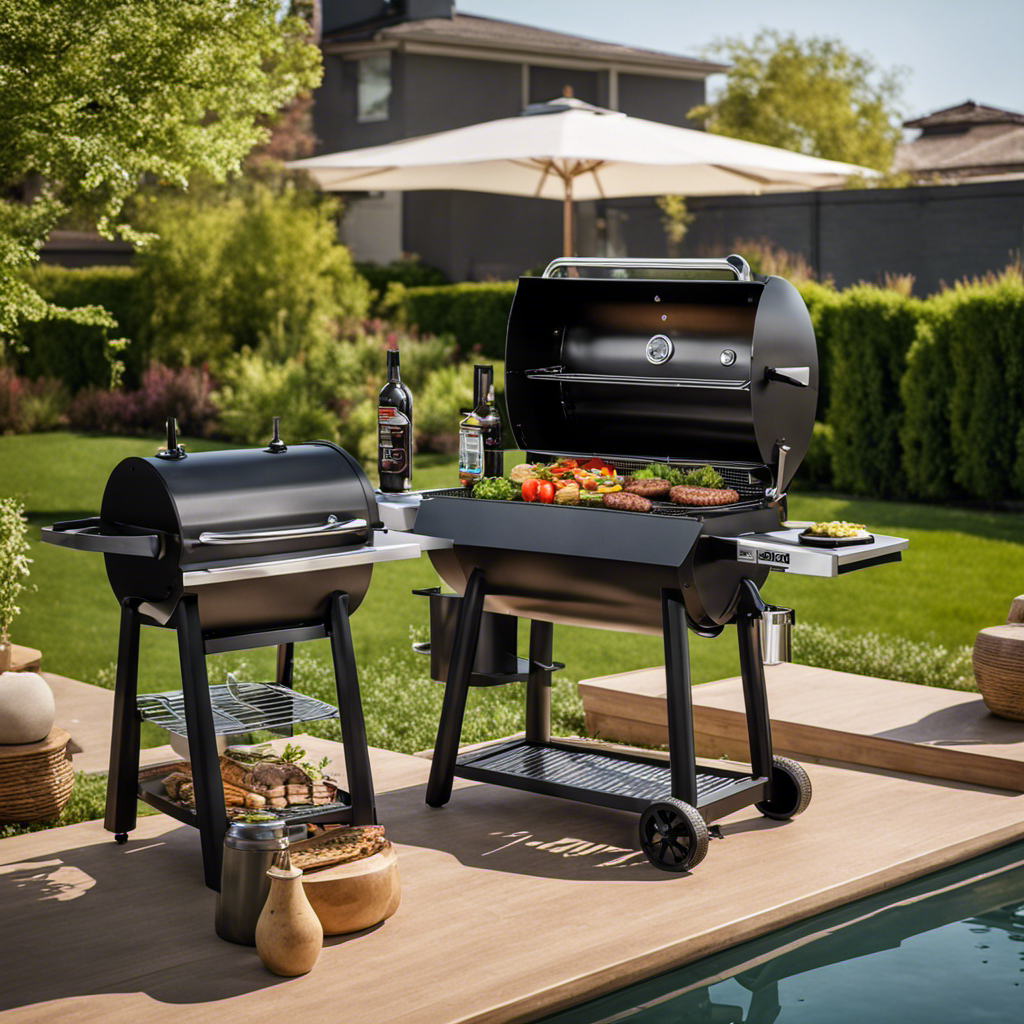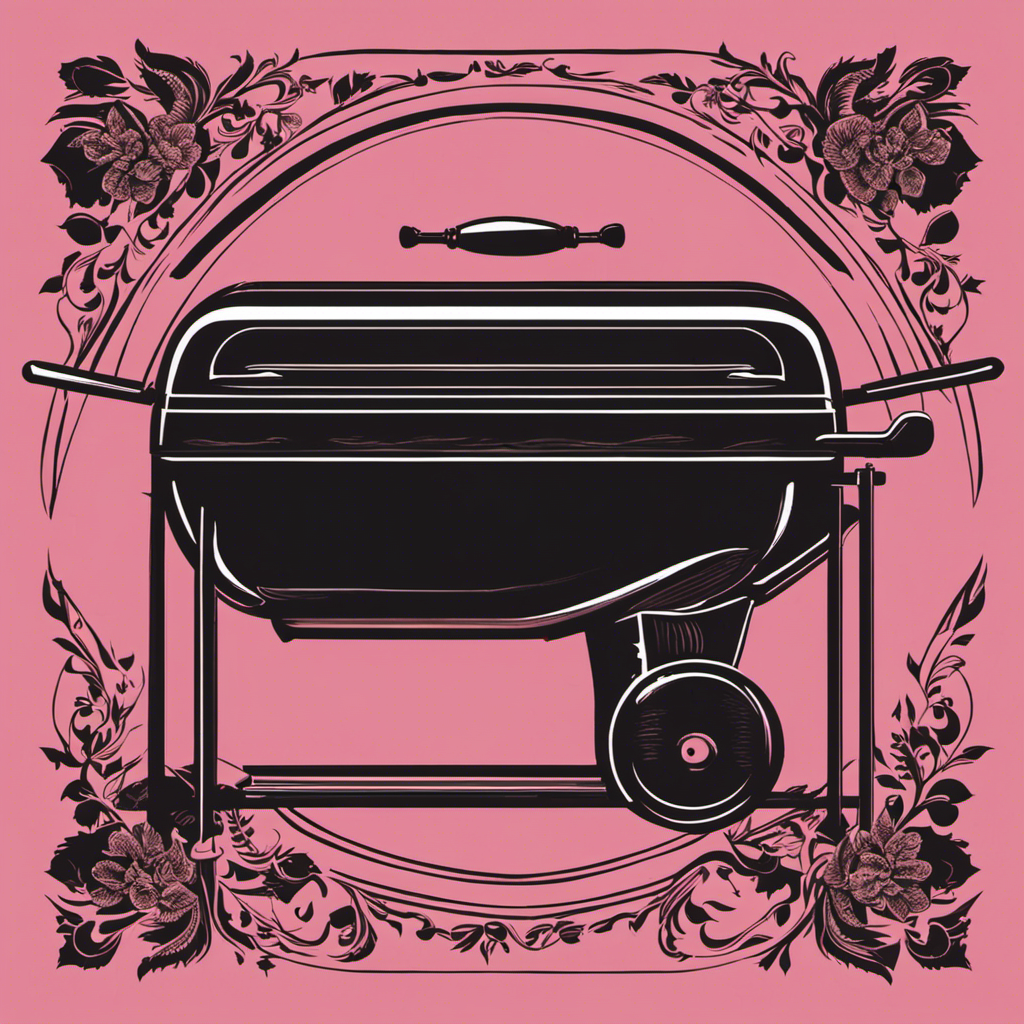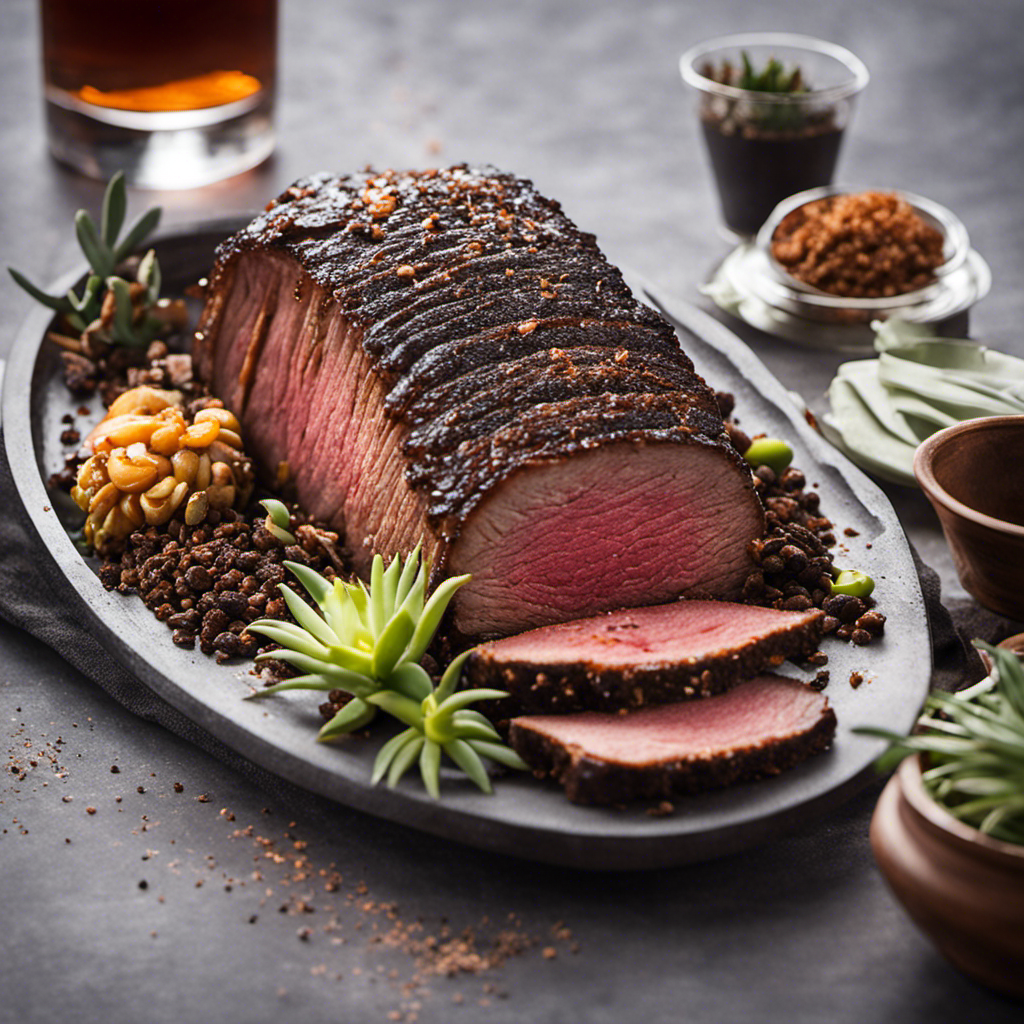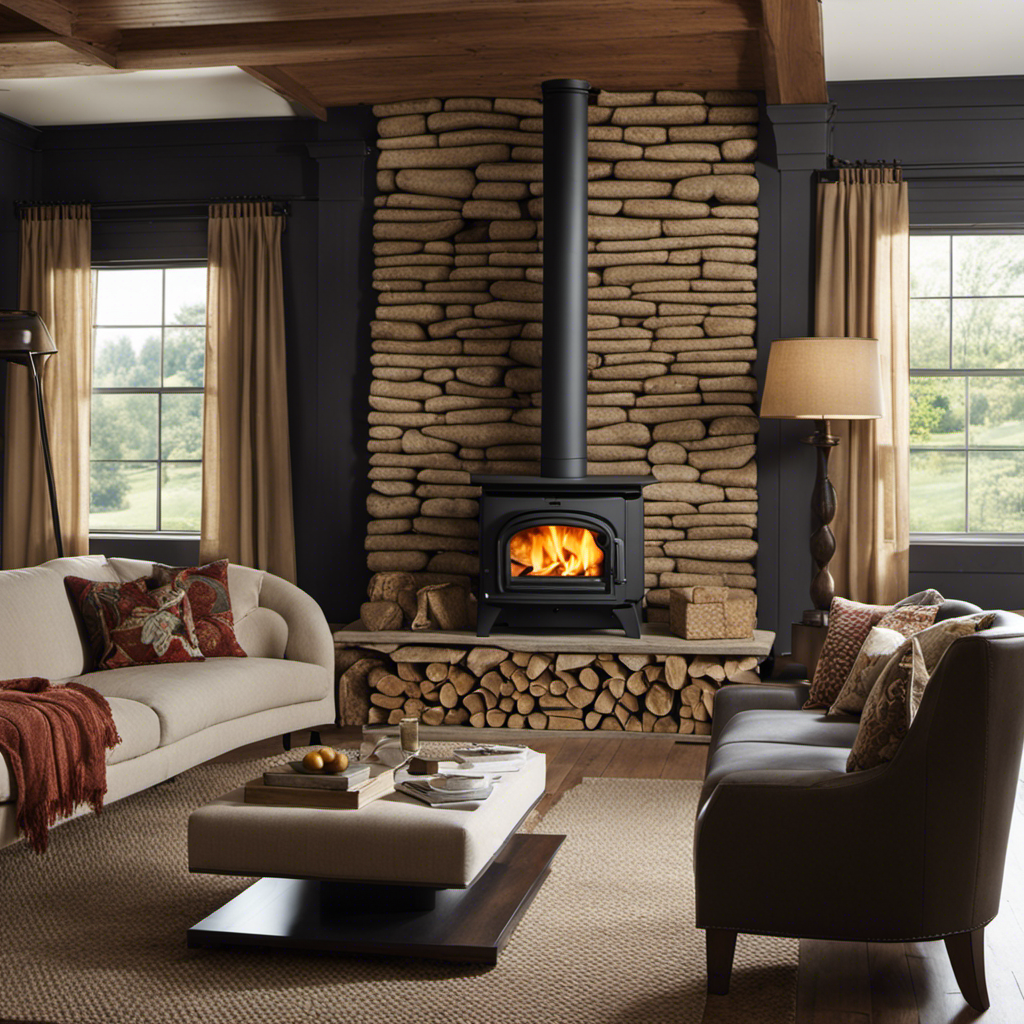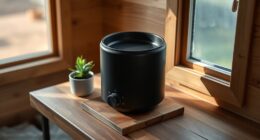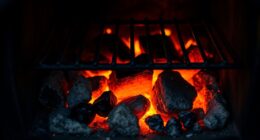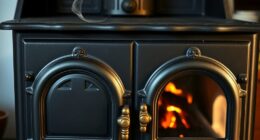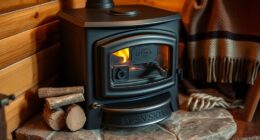Many of us have dealt with the unpleasant odor emanating from our pellet stoves, which can be rather bothersome. However, don’t worry, as we’re here to assist you!
In this article, we’ll delve into the reasons behind why your pellet stove stinks and provide you with practical solutions to fix it.
From ensuring proper airflow to cleaning vents and filters, we’ve got you covered.
Say goodbye to that stinky odor and enjoy the benefits of a clean and efficient pellet stove.
Key Takeaways
- A pellet stove may smell like smoke when unused, but this is temporary and normal as it burns away dust and wood.
- The smell of burning plastic and gaps between panels in a new pellet stove should dissipate after 3-4 days, but if it persists, check for vent leaks.
- Using wet pellets in a pellet stove can cause actual smoke, so it’s important to use dry pellets stored in a climate-controlled area.
- Common causes of a smoke smell from a pellet stove include poor combustion, a dirty exhaust system, low-quality or damp pellets, inadequate ventilation, or a malfunctioning stove. To address this issue, clean the exhaust system, use high-quality and dry pellets, ensure proper ventilation, adjust the air-to-fuel ratio, and seek professional assistance if necessary.
Reasons for a Smoky Smell in Your Pellet Stove
One possible reason for a smoky smell in our pellet stove is the use of wet pellets, which can cause inefficient burn and smoke production. Wet pellets contain moisture that hinders proper combustion, leading to the production of smoke.
Understanding the causes of smoke in pellet stoves is crucial for preventing smoke and odor. To prevent this, it’s important to use dry pellets and store them in a climate-controlled area. Additionally, regularly cleaning the stove’s vents and filters can prevent debris accumulation and ensure proper airflow. Increasing the temperature can also minimize smoke production.
The Impact of an Unused Pellet Stove on Smell
When we first light our pellet stove after a period of inactivity, we may notice a smell of smoke. This is a normal and temporary occurrence, as the stove burns away accumulated dust and wood particles.
The impact of an unused pellet stove on odor is mainly due to the soot and materials from previous use burning first. To prevent a smoky smell in an unused pellet stove, there are a few ways we can take action.
- Ensuring proper ventilation and increasing airflow around the stove can help minimize smoke production.
- Regularly cleaning vents and filters prevents debris accumulation that could contribute to a smoky smell.
- Using new, sealed pellets for a hotter burn and reduced soot is also recommended.
- Additionally, increasing the temperature can help minimize smoke production.
Overall, by following these tips, we can prevent or minimize the smoky smell in an unused pellet stove.
Understanding the Odor of a New Pellet Stove
As we light our new pellet stove, we may notice a smell of burning plastic and gaps between the panels initially, which should dissipate after a few days. This is a common occurrence with new pellet stoves and is nothing to be alarmed about.
The smell of burning plastic is caused by the paints and adhesives used in the manufacturing process, which need time to harden. As for the gaps between the panels, they’re a result of the expansion and contraction of the materials as they heat up and cool down.
To reduce the plastic odor, it’s important to ensure proper ventilation techniques. This includes making sure the stove is installed in a well-ventilated area and that the flue and venting system are functioning properly. Additionally, allowing fresh air to circulate around the stove can help to dissipate the odor more quickly.
The Role of Wet Pellets in Stinky Stove Situations
The presence of moisture in our pellets can lead to an inefficient burn and the production of smoke. To ensure optimal stove performance and prevent smoke and odor, it’s important to use dry pellets instead of wet ones.
Here are three key reasons why using dry pellets is essential:
-
Efficient combustion: Dry pellets burn more efficiently, producing more heat and less smoke. This results in a cleaner and more effective burn, maximizing the stove’s performance.
-
Reduced smoke production: Wet pellets contain moisture, which hinders the combustion process and leads to the production of smoke. By using dry pellets, you can significantly minimize smoke emissions, creating a healthier and more pleasant environment.
-
Avoiding pellet degradation: Moisture in pellets can cause them to degrade, resulting in clumping, clogging, and inconsistent fuel feed. By using dry pellets, you can prevent these issues and ensure a smooth and uninterrupted operation of your stove.
Addressing Leaky Vents and Lingering Smoke Smells
To eliminate lingering smoke smells and address leaky vents, we should promptly inspect and seal any leaks in the venting system of our pellet stove. Regular venting system maintenance is essential to ensure the proper functioning of our pellet stove and prevent smoke smells from permeating our living space. If we notice persistent smoke smells or suspect a leak in the venting system, it may be necessary to seek professional assistance to identify and fix the issue.
In the table below, we outline the importance of venting system maintenance and the benefits of professional assistance in addressing vent leaks and smoke smells:
| Importance of Venting System Maintenance | Benefits of Professional Assistance |
|---|---|
| Ensures proper ventilation | Expertise in identifying leaks |
| Prevents smoke smells | Proper sealing of vent leaks |
| Enhances stove performance | Minimizes risk of further issues |
Increasing Airflow to Eliminate Smoke in Your Stove
We can improve the efficiency of our pellet stove and reduce smoke by increasing the airflow around it. Here are three ways to achieve this:
-
Clean the vents and filters regularly to prevent debris accumulation and ensure proper airflow.
-
Check the venting system for any leaks that may be causing smoke to linger. Repair or replace any damaged parts.
-
Troubleshoot the pellet stove igniter to ensure it’s working properly. A malfunctioning igniter can lead to inefficient burning and increased smoke production.
By implementing these measures, we can enhance the performance of our pellet stove and eliminate unwanted smoke.
Remember to perform venting system maintenance regularly and address any issues with the igniter promptly to enjoy a clean and efficient heating experience.
Regular Maintenance to Prevent Smoke and Odor
Regular maintenance is crucial for preventing smoke and odor from your pellet stove. By keeping up with regular maintenance tasks, you can ensure that your stove operates efficiently and without any unpleasant smells.
To prevent odor, it’s important to clean your stove regularly. This includes cleaning the ashtray, vents, and filters to remove any built-up debris or residue. Additionally, inspecting and cleaning the exhaust system can help eliminate any potential sources of smoke or odor.
Another important aspect of regular maintenance is checking and replacing the gaskets and seals on your stove. Over time, these components can wear out and cause air leaks, which can lead to smoke and odor. By replacing these parts as needed, you can maintain proper airflow and prevent any unwanted smells.
Using High-Quality Pellets for a Cleaner Burn
Using high-quality pellets ensures a cleaner burn and reduces the likelihood of smoke and odor from our stove. When it comes to pellet stove maintenance, choosing the right stove fuel is crucial. Here are three reasons why using high-quality pellets is essential:
-
Efficient combustion: High-quality pellets are made from compressed wood fibers without additives, ensuring a consistent and efficient burn. This leads to less smoke production and a cleaner burn, reducing the chance of odor lingering in the air.
-
Reduced ash and residue: Low-quality pellets often contain more impurities, resulting in higher ash content and residue buildup in your stove. High-quality pellets produce less ash, minimizing the need for frequent cleaning and reducing the chances of any lingering smoky smell.
-
Environmental friendliness: High-quality pellets are often made from sustainable sources, such as sawdust and wood shavings. Choosing these pellets helps reduce the environmental impact of your pellet stove while providing a cleaner and more pleasant burning experience.
Adjusting Temperature to Minimize Smoke Production
When adjusting the temperature on our pellet stove, we can effectively minimize smoke production and ensure a cleaner burn. By properly adjusting the thermostat, we can control the amount of fuel being burned, which in turn affects the amount of smoke produced.
One technique to reduce smoke is to gradually increase the temperature setting instead of quickly raising it. This allows the stove to efficiently burn the pellets without creating excess smoke.
Additionally, it’s important to ensure that the stove is properly cleaned and maintained, as a dirty stove can contribute to increased smoke production. Regularly cleaning the ashtray and checking for any blockages in the exhaust system can help prevent smoke issues.
The Importance of Cleaning the Ashtray
Cleaning the ashtray is an essential task when it comes to maintaining a pellet stove and preventing it from stinking. Ashes and residue can accumulate in the ashtray over time, leading to unpleasant odors and even potential fire hazards. Regularly cleaning the ashtray not only eliminates these issues but also ensures optimal performance and longevity of the stove.
Here are three key reasons why cleaning the ashtray is important:
-
Preventing odor buildup: Ashes and burnt particles can emit foul smells if left unattended. By cleaning the ashtray frequently, you can eliminate these odors and maintain a fresh and clean environment in your home.
-
Fire prevention: Ashes that accumulate in the ashtray can smolder and potentially cause a fire. Regular cleaning reduces the risk of fire hazards and keeps your pellet stove safe to use.
-
Enhancing efficiency: A clean ashtray allows for proper airflow and combustion, resulting in efficient burning of pellets and reduced smoke production. This not only improves the performance of your pellet stove but also lowers maintenance and fuel costs.
Alternative solutions, such as using disposable ashtray liners or ash vacuum cleaners, can also be considered for easier and more convenient ash removal. However, regardless of the method chosen, it’s crucial to clean the ashtray regularly to ensure the optimal functioning and safety of your pellet stove.
Troubleshooting Common Pellet Stove Auger Issues
One common issue we’ve encountered with pellet stove augers is jamming, which can be caused by a variety of reasons. Troubleshooting auger jams is essential to improve the performance of your pellet stove. Here are some common causes of auger jams and ways to address them:
| Causes of Auger Jams | Ways to Improve Auger Performance |
|---|---|
| 1. Foreign objects in the auger tube | – Regularly inspect and clean the auger tube |
| 2. Excessive pellet dust or fines | – Use high-quality pellets with low dust content |
| 3. Auger motor malfunction | – Check the motor for any issues and replace if necessary |
Comparing Pellet Stoves to Kerosene Heaters: Environmental Impact and More
In terms of environmental impact and fuel requirements, pellet stoves offer a more sustainable and efficient option compared to kerosene heaters. Here are three reasons why:
-
Environmental benefits: Pellet stoves use renewable biomass pellets made from compressed sawdust or agricultural waste, reducing reliance on fossil fuels and decreasing carbon emissions. Kerosene heaters, on the other hand, burn non-renewable petroleum-based fuels, contributing to air pollution and climate change.
-
Heat distribution: Pellet stoves are designed to distribute heat evenly throughout a space, thanks to their built-in fans and adjustable settings. This ensures that warmth reaches every corner of the room, maximizing comfort and reducing the need for additional heating sources. Kerosene heaters, on the other hand, may produce localized heat that doesn’t reach the entire area efficiently.
-
Efficiency: Pellet stoves are highly efficient, with combustion efficiencies typically above 80%. This means that a large majority of the fuel is converted into heat, minimizing waste and maximizing energy usage. In contrast, kerosene heaters may have lower combustion efficiencies, leading to higher fuel consumption and increased costs.
Overall, choosing a pellet stove over a kerosene heater not only benefits the environment but also provides better heat distribution and increased efficiency.
-Can the Smell of Wood Smoke from a Pellet Stove Indicate a Problem?
If your wood pellet stove smells strongly of wood smoke, it could indicate a problem with the stove such as a build-up of creosote or an issue with the combustion process. It’s important to address any unusual odors promptly to ensure the safety and efficiency of your stove.
Can the Smell from a Wood Pellet Stove Impact the Smell of a Pellet Stove?
The wood pellet stove odor prevention is essential for maintaining a pleasant atmosphere in your home. While the smell from a wood pellet stove can be natural, proper maintenance and cleaning can prevent any unpleasant odors from impacting the overall smell of the stove.
Frequently Asked Questions
Can a Smoky Smell in a Pellet Stove Be Caused by Poor Combustion?
Poor combustion can indeed cause a smoky smell in a pellet stove. When the combustion process isn’t efficient, it can lead to incomplete burning of the pellets, resulting in the production of smoke and a strong odor.
Troubleshooting pellet stove smoke caused by poor combustion involves cleaning the exhaust system, ensuring proper ventilation, and adjusting the air-to-fuel ratio.
If the problem persists, it’s advisable to seek professional assistance to address the issue effectively.
How Can I Clean the Exhaust System of My Pellet Stove?
When it comes to cleaning the exhaust system of your pellet stove, there are a few important procedures to follow.
First, make sure to turn off the stove and allow it to cool completely.
Then, remove any debris or ash from the exhaust pipe using a brush or vacuum.
Next, check for any common exhaust system issues such as leaks or blockages.
Finally, wipe down the exterior of the pipe with a damp cloth.
Regularly cleaning the exhaust system will help maintain the efficiency and performance of your pellet stove.
What Can I Do if My Pellet Stove Is Producing a Lot of Smoke Even With Dry Pellets?
If your pellet stove is producing a lot of smoke even with dry pellets, there are troubleshooting tips you can try.
First, check for any blockages in the exhaust system and clean it if necessary.
Ensure proper ventilation by adjusting the air-to-fuel ratio and increasing airflow around the stove.
Use high-quality pellets and make sure they’re stored in a dry area.
If the problem persists, it may be best to seek professional assistance to address any potential malfunctions.
Should I Adjust the Air-To-Fuel Ratio in My Pellet Stove to Reduce Smoke Production?
Adjusting the air-to-fuel ratio in your pellet stove can indeed help reduce smoke production. By increasing the airflow, you can achieve a more complete combustion, resulting in less smoke.
However, it’s important to note that adjusting this ratio should be done carefully to avoid damaging the stove or affecting its efficiency. Regular maintenance, including cleaning vents and filters, is also crucial for optimal performance and to prevent smoke-related issues.
Taking these steps can ensure a cleaner and more efficient operation of your pellet stove.
When Should I Seek Professional Assistance for a Smoky Smell in My Pellet Stove?
When experiencing a smoky smell in our pellet stove, there are times when seeking professional assistance is necessary. If troubleshooting techniques like adjusting the air-to-fuel ratio have been tried without success, it may be time to call in a professional.
They can thoroughly inspect the stove, identify any underlying issues, and provide expert guidance on how to resolve the problem. It’s important to address the smoky smell promptly to ensure the stove operates efficiently and safely.
Conclusion
In conclusion, by addressing the various factors that can cause a smoky smell in your pellet stove, such as proper airflow, regular cleaning, high-quality pellets, and temperature adjustments, you can finally bid farewell to that unpleasant odor.
Remember, a clean and efficient pellet stove not only eliminates the stink but also provides you with the benefits of warmth and comfort.
So, let’s embrace a fresh and inviting atmosphere in our homes, leaving behind the smoke and embracing the sweet scent of a well-functioning pellet stove.
Logan’s affair with adventure began in childhood. He hailed from a small town where vast forests bordered one side and endless shores stretched on the other. His days were spent exploring uncharted woods, climbing tall trees, or listening to the tales of old sailors. This early immersion in a world brimming with stories and mysteries became the foundation of his passion for writing.


